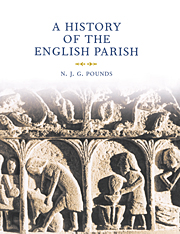Book contents
- Frontmatter
- Contents
- List of illustrations
- Preface
- List of abbreviations
- PART I THE ORIGINS OF THE PAROCHIAL SYSTEM
- PART II THE FUNCTIONS OF THE PARISH
- PART III THE PARISH AND ITS CHURCH
- 10 The parish: its church and churchyard
- 11 The fabric of the church: the priest's church
- 12 The peoples's church: the nave and the laity
- Notes
- Index
10 - The parish: its church and churchyard
Published online by Cambridge University Press: 29 July 2009
- Frontmatter
- Contents
- List of illustrations
- Preface
- List of abbreviations
- PART I THE ORIGINS OF THE PAROCHIAL SYSTEM
- PART II THE FUNCTIONS OF THE PARISH
- PART III THE PARISH AND ITS CHURCH
- 10 The parish: its church and churchyard
- 11 The fabric of the church: the priest's church
- 12 The peoples's church: the nave and the laity
- Notes
- Index
Summary
for we bulde
A chirche and a chapaille with chambers a-lofte,
Wi wide windowes y-wroute & walles well heye.
Þat mote bene portreid and paynt & pulched ful clene
WiÞ gaie glittering glas glowing as Þe sonne
Pierce the Plowman's CredeThere is an instant appeal in the view of a village, its cottages built of local and traditional materials and dominated by the tower of its church. It suggests immemorial antiquity; it seems always to have been there, epitomising the deep, local roots of English society. But this is largely an illusion. The cottages may go no further back than the ‘great rebuilding’ of the seventeenth or eighteenth centuries. The hedgerows and the scattered trees are likely to have been the consequence of the enclosure movement, and the clustered settlement may itself not be very much older. The buildings carry no datestone, telling us when they were created, but the church is different. There is a strong probability that much of its fabric dates from the Middle Ages, some parts of it perhaps from as early as the Saxon period. It is a product of slow accretion, added to, rebuilt piecemeal, ornamented and defaced over a period of perhaps a thousand years. It is a wonderful palimpsest on which successive generations have written.
- Type
- Chapter
- Information
- A History of the English ParishThe Culture of Religion from Augustine to Victoria, pp. 371 - 429Publisher: Cambridge University PressPrint publication year: 2000



